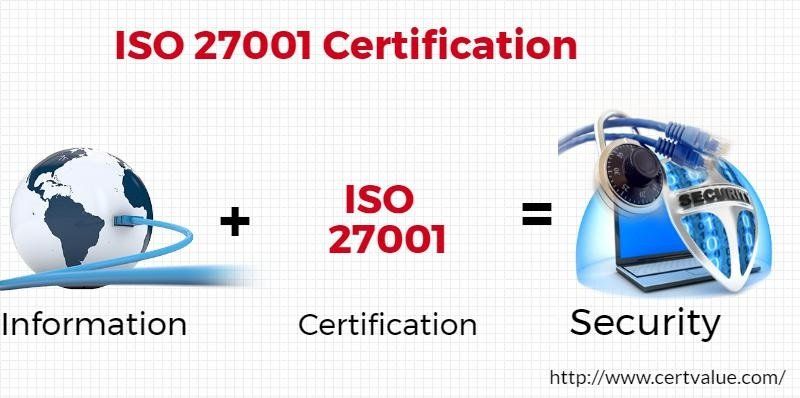ISO 27001 Certification in Kuwait
- By cert value
- •
- 26 Jul, 2018
- •
ISO 27001 implementation checklist

ISO 27001 Certification in Kuwait published by International Standardization Organization (ISO) is globally recognized and popular standard to manage information security across all organizations. It exists to help all organizations irrespective of its type, size and sector to keep information assets secured.
Main Purpose
The security of assets like financial information, intellectual property, employee information entrusted by third parties etc. in an Organization depends on the workplace, processes, IT Systems and human resources skill set, attitude, etc. The organization considers achieving ISMS Information Security Management System to assure the regulatory bodies, customers and other stakeholders. An ISO 27001 certified organization indicates it commitment on Information security regulations, demonstrate its ability to manage risks, protect information assets at workplace and provide assurance to comply with security requirements to all management stakeholders including customers.
ISO 27001 implementation in Kuwait is a systematic PDCA framework approach of following repeated steps
1. Plan
- Identification of business objectives
- Document management perspective on security policy.
- Analysis of the security policy and select its scope of implementation.
- Define a method of risk assessment
- Prepare an inventory of information assets to protect, and rank assets according to risk classification based on risk assessment.
2. Do
- Define risk treatment plan to control the risks.
- Document policies and procedures on Risk Control.
- Identify human resources and train them.
3. Check
- Monitor the implementation of the ISMS.
- Prepare for the certification audit.
4. Act
- Conduct periodic reassess of risk control processes to implement
a) Continual improvement
b) Corrective action
c) Preventive action
Benefits
The following are the benefits to an ISO 27001 certified organization:-
- Identify and protect information assets against potential risks.
- Reduce the potential for security threats and its associated operational costs.
- Aid legal and security compliance
- Improve overall performance by improving employee efficiency.
- Emergency preparedness and response.
Implementation Process
The implementation of ISO 27001 standard takes lot of effort and time. It contains below nine steps
1. Project mandate
The implementation project should begin by appointing a project leader, who will work with other members of staff to create a project mandate. This is essentially a set of answers to these questions:
- What are we hoping to achieve?
- How long will it take?
- What will it cost?
- Does it have management support?
2. Project initiation
Organizations should use their project mandate to build a more defined structure that goes into specific details about information security objectives and the project’s team, plan and risk register.
3. ISMS initiation
The next step is to adopt a methodology for implementing the ISMS. ISO 27001 recognizes that a “process approach” to continual improvement is the most effective model for managing information security. Organizations have to select one of the feasible methods or to continue with a model they already have in place.
4. Management framework
At this stage, the ISMS will need a broader sense of the actual framework. Part of this will involve identifying the scope of the system, which will depend on the context. The scope also needs to take into account mobile devices and teleworkers.
5. Baseline security criteria
Organizations should identify their core security needs. These are the requirements and corresponding measures or controls that are necessary to conduct business.
6. Risk management
ISO 27001 allows organizations to broadly define their own risk management processes. Common methods focus on looking at risks to specific assets or risks presented in specific scenarios. There are pros and cons to each, and some organizations will be much better suited to one method than the other.
There are five important aspects of an ISO 27001 risk assessment:
- Establishing a risk assessment framework
- Identifying risks
- Analyzing risks
- Evaluating risks
- Selecting risk management options
7. Risk treatment plan
This is the process of building the security controls that will protect your organization’s information assets. To ensure these controls are effective, you will need to check that staff are able to operate or interact with the controls and that they are aware of their information security obligations.
You will also need to develop a process to determine, review and maintain the competences necessary to achieve your ISMS objectives. This involves conducting a needs analysis and defining a desired level of competence.
8. Measure, monitor and review
For an ISM to be useful, it must meet its information security objectives. Organizations need to measure, monitor and review the system’s performance. This will involve identifying metrics or other methods of gauging the effectiveness and implementation of the controls.
9. Certification
Once the ISMS is in place, organizations should seek certification from an accredited certification body. This proves to stakeholders that the ISMS is effective and that the organization understands the importance of information security.
The certification process will involve a review of the organization’s management system documentation to check that the appropriate controls have been implemented. The certification body will also conduct a site audit to test the procedures in practice.
Our Advice:-
To know more about ISO 27001 Certification feel free to write to us at contact@certvalue.com and visit our official website at www.certvalue.com. We at Certvalue follow streamlined value added to understand requirement and to identify the best suitable process How to get ISO 27001 Certification in Kuwait for your Organization with less cost and accurate efficiency.